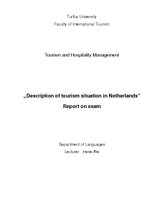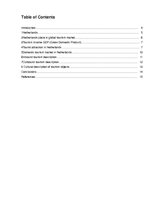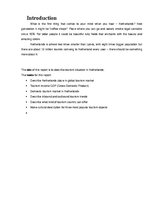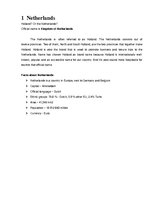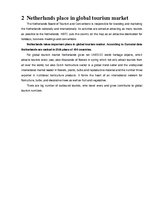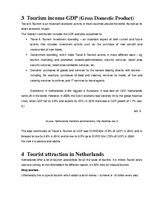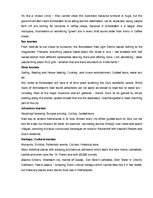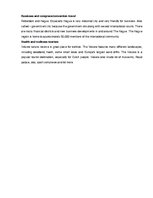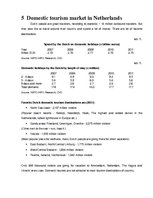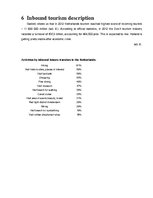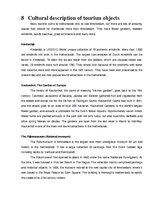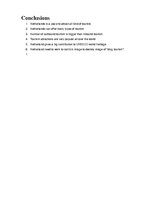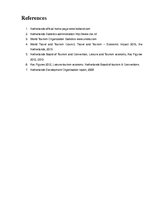-
Description of Tourism Situation in Netherlands
| Nr. | Sadaļas nosaukums | Lpp. |
| Introduction | 3 | |
| 2. | Netherlands | 4 |
| 3. | Netherlands place in global tourism market | 5 |
| 4. | Tourism income GDP (Gross Domestic Product) | 6 |
| 5. | Tourist attraction in Netherlands | 7 |
| 6. | Domestic tourism market in Netherlands | 9 |
| 7. | Inbound tourism description | 10 |
| 8. | Outbound tourism description | 11 |
| 9. | Cultural description of tourism objects | 12 |
| Conclusions | 13 |
Keukenhof: The Garden of Europe
The history of Keukenhof, the name of meaning "kitchen garden", goes back to the 15th century. Countess Jacqueline of Bavaria, Jacoba van Beieren gathered fruit and vegetables from the woods and dunes her for the kitchen of Teylingen Castle. Keukenhof Castle was built in 1641, and the estate grew to an area of over 200 hectares. Keukenhof Gardens is the world’s largest flower garden, and actually a promotion for the Dutch flower industry. Approximately seven million flower bulbs are planted annually in the park with not only tulips, but also hyacinths, daffodils and other spring flowers on display. The gardens are open from the last week in March to mid-May. Keukenhof is one of the most visit tourist attractions in the Netherlands.
The Rijksmuseum (National museum)
The Rijksmuseum in Amsterdam is the largest and most prestigious museum for art and history in the Netherlands. It has a large collection of paintings from the Dutch Golden Age including works by Vermeer and Rembrandt.
The Rijksmuseum first opened its doors in 1800 under the name ‘Nationale Kunstgalerij’. At the time, it was housed in Huis ten Bosch in The Hague. The collection mainly comprised paintings and historical objects. In 1808, the museum moved to the new capital city of Amsterdam, where it was based in the Royal Palace on Dam Square. The building is thoroughly modernized, to satisfy the needs of its 21st-century visitors.
Conclusions
1. Netherlands is a place to attract all kind of tourists
2. Netherlands can offer many types of tourism
3. Number of outbound tourism is bigger than inbound tourism.
4. Tourism attractions are very popular all over the world
5. Netherland gives a big contribution to UNESCO world heritage
6. Netherland need to work to contry’s image to destroy image of “drug tourism”.
…
The Netherlands Board of Tourism and Conventions is responsible for branding and marketing the Netherlands nationally and internationally. Its activities are aimed at attracting as many tourists as possible to the Netherlands. NBTC puts the country on the map as an attractive destination for holidays, business meetings and conventions. Netherlands takes important place in global tourism market. According to Eurostat data Netherlands are ranked in 25th place of 184 countries. Economics in Netherlands is 6th biggest in Eurozone. If wee look on GDP Netherlands ranks 24 in the world. However, in 2009, the Dutch economy was severely hit by the global financial crisis, when GDP fell by 3.9% and exports by 25%. In 2010 there was a GDP growth of 1.7% (tab. 4.1)

